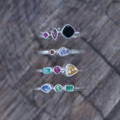Your Cart is Empty
Figuring out Finger Types
The human body is a unique thing. We all have our own set of corners and curves that we have to figure out whenever we are buying things.
Did you know that rings require some figuring out too?
We all have different finger types. Finding your perfect ring means figuring out your finger type. A ring with the right fit will sit comfortably: loose enough to slide over your knuckle with some resistance, but snug enough so that it won’t fall off.
The long and short of figuring out your finger type is getting to know your knuckles. They’re those knobby things that enable your fingers to move and bend the way that they do. They’re key to how your ring fits.
You should be able to slide your ring on and off without a struggle, and it will stay on without any problem. Too much force in putting it on or off is not something you want (like when my mom tried to take off her wedding band after nearly 25 years of marriage and three kids - ouch).
TAPERED | FINGERS BIGGER THAN KNUCKLES
Tapered finger has a larger base and smaller knuckle. Be careful with rings sliding out and slipping off!
A tapered finger is where your fingers are larger at the base then gradually tapering, without a prominent knuckle. Rings can more easily slip off if they slide up, as your knuckles won't keep your ring on your finger.
Pick a ring that’s snug to keep you from losing it. If the tightness of the band bothers you, a more narrow band will feel more comfortable.
KNOTTED | KNUCKLES BIGGER THAN FINGERS
Knotted finger has wide knuckles and smaller base. Choose a ring size in between the size of your knuckle and your base.
If you’re one of those people who have skinny fingers and big knuckles, you have knotted fingers. Sizing can be tricky.
If your knuckles are larger than the base of the finger, measure both the knuckle and finger and select a size in between the two. This way your ring can fit over your knuckle without too much struggle as you slide it on. The ring may be a little loose on your finger. It might move around a little, but that gorgeous stone you picked as your ring’s centerpiece won’t end up on the inside of your palm where no one can see it.
Pro tips
Here’s a list of things that you don’t want when you choose a ring:
Indent marks at the base of your finger. Blood circulation is very important. Let’s not cut off your blood supply.
It won’t turn around your finger. A little wiggle room is ideal, especially as our finger sizes will also change with any major changes to our body.
No friction is not great. You need some friction to prevent the ring from falling off of your finger.
Your ring shouldn’t create a "muffin top" of skin on either side of it.
You shouldn't notice pain or tingling in your ring finger while you're wearing your band. That’s way too tight my friend.
still not sure of Your ring size?
When you’re ready to order your first jewelry online (or plan to “accidentally” leave a browser open to hint to your partner about your dream ring), you could go to a jeweler to get yourself sized.
But hey, we all love pyjamas and some of us have a little more social anxiety than others, so here are some tips so you might not even need to leave that cushiony, dented spot on your sofa.
You can compare the major ring sizing options right here and see which one is best for you.
Adjustments, Tweaks & More Ring Sizing Tips
Knotted fingers have wide knuckles and smaller base. Choose a ring size in between the size of your knuckle and your base.
Ring style matters. Certain rings may fit differently on the same finger, so keep this in mind as you’re sizing:
Wider bands (compared to a dainty stacker band) have less “give” for slipping over your knuckle, so you may need to increase the ring size. Order a half size larger than you usually would for bands 3.5 mm or wider.
Size up a quarter to half a size when you plan to stack your rings.
Rings with open bands, are slightly adjustable. Depending on the metal, you may shape or form the ring ever so slightly to adjust the fit.
If you end up with a ring that doesn't fit, it's not the end of the world. You know we want you happy, and we're here to help. Email us and we'll make sure you end up with a gorgeous ring to not only admire, but actually wear!















